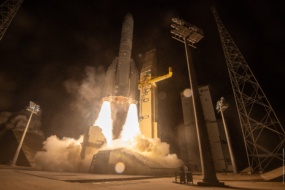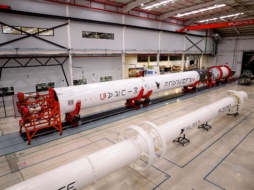A puppet-esque system that can simulate low gravity conditions will help the next generation of European astronauts train for working in space.
Space Applications Services will install its Puppeteer system at the LUNA lunar simulation facility being built by DLR and ESA in Germany, the company announced Tuesday. The system utilizes several independent ceiling crawlers equipped with a Constant Force Module—a complex mechanical system of springs first developed to support workout equipment on the ISS—that can simulate the various gravitational forces of the Moon, Mars, or open space.
Deep dive: Training astronauts to work on the Moon, where the gravity is 1/6 that of Earth, is no simple task, and space agencies go to great lengths to simulate the otherworldly environments.
- Parabolic flights: By flying a plane up and down like a roller coaster (it’s nicknamed the Vomit Comet for a reason), astronauts are able to experience weightlessness for about 20 seconds at a time. ESA astronauts in training will fly these flights three times in a week to experience about 90 brief periods of weightlessness.
- Neutral Buoyancy Lab: At the Johnson Space Center in Houston, NASA operates one of the world’s largest indoor swimming pools to simulate space environments for astronaut training.
“You can guess that the price of that facility, the difficulty, the risk associated, and the management is a full nightmare. So that means that the time each astronaut is allowed to spend in the neutral buoyancy lab is very minimal,” Guillaume Fau, a robotics engineer at Space Applications Services, said.
The puppet show: The Puppeteer system improves on many of these issues while cutting costs.
- Any direction: The Puppeteer ceiling crawler has omnidirectional capabilities, and can respond to the user’s movement with precision.
- Constant Force Module: The system provides a consistent, adjustable counterforce to simulate any low-G environment.
- Flexible deployments: Puppeteer can be deployed onto an existing ceiling or in a self-standing frame, opening the door for future applications with other astronaut training facilities.
Strings attached: Space Applications will deliver a single demonstration Puppeteer crawler by July, with plans to integrate a full system of four vehicles into the 700-sq-m lunar training facility the following year—three for astronauts and one that can be used to simulate a heavier payload, such as a lunar rover. DLR will have the option to purchase more vehicles down the line.
The company is also in talks with other space agencies including NASA and the Italian Space Agency, who’ve shown interest in deploying this technology to train their own astronauts and scientists, Fau said.




